구강호흡과 게이핑, Mouth breathing and gaping
|
다음은 “애가 혀를 내밀고 있어요, 입으로 숨 쉬어요–구강 호흡, 게이핑”에 관한 인터넷 소아청소년 건강상담 질의응답의 예 입니다. |
Q&A. 애가 혀를 내밀고 있어요, 입으로 숨 쉬어요–구강 호흡, 게이핑
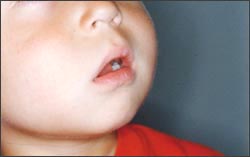
사진 95. 알레르기 비염으로 코가 막히면 입을 벌리고 입으로 숨 쉰다. 이런 호흡을 “구강호흡” 또는 “게이핑(Gaping)”이라도 한다.
Copyright ⓒ 2011 John Sangwon Lee, MD., FAAP
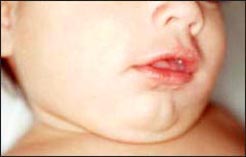
사진 96. 알레르기 비염 으로 코가 막히면 입을 벌리고 입을 통해 숨 쉰다. 이런 호흡을 구강호흡 또는 게이핑이라 한다.
Copyright ⓒ 2011 John Sangwon Lee, MD., FAAP
- 알레르기 비염이 적절히 잘 치료되지 않으면 이런 경구호흡 증상 징후가 신생아기 때부터 사춘기가 될 때까지 계속될 수 있고 성인이 된 이후에도 계속 나타날 수 있다.
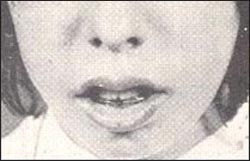
사진 97. 알레르기 비염으로 코가 막히면 입을 벌리고 숨을 쉴 수 있다
출처:Used with permission from Annals of Allergy와 소아가정간호백과
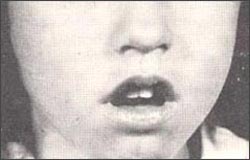
사진 98. 알레르기 비염으로 코가 막히면 입을 벌리고 숨 쉰다.
출처:Used with permission from Annals of Allergy와 소아가정간호백과
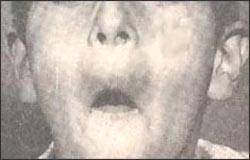
사진 99. 알레르기 비염의 증상으로 얼굴을 실룩거릴 수 있다.
Used with permission from Annals of Allergy와 소아가정간호백과

사진 100. 알레르기 비염으로 얼굴을 실룩거릴 수 있다.
Used with permission from Annals of Allergy와 소아가정간호백과
Q.
10개월 된 남자아이를 둔 엄마입니다. 최근에 아이가 거의 혀를 내밀고 있어요. 잠을 잘 때에도 입안을 보면 잇몸사이로 혀를 내밀고 있어요. 놀 때에는 입술과 입술사이로 혀를 내밀고 있고 잘 때에는 입속에서 그러고 있어요. 왜 그런 걸까요. 그리고 아랫니가 2개 윗니가 1개 났는데 아랫니가 윗니보다 더 나와 있어요. 그럼 입모양이 보기 안 좋던데 평소에 젖꼭지를 잘 물고 있어서 그런 건가요? 만약 교정을 해야 한다면 언제쯤 해야 할까요? 도움말씀 부탁드립니다.
A.
아님님
안녕하십니까. 좋은 질문해 주셔서 감사합니다.
자녀의 나이와 성별, 과거 현재 가족의 병력, 증상 징후와 진찰소견, 적절한 임상검사 등의 결과를 종합해서 진단 치료하는 것이 이상적이지만 주신 정보를 참작해서 답변을 드립니다.
입을 자주 벌리고 숨 쉬는 습관을 게이핑(Gaping)또는 구강호흡이라고 합니다.
게이핑의 원인은 많습니다.
상악에 기형이 있거나 하악에 기형이 있거나 코에 알레르기 비염이 있을 때 그런 병의 증상 징후로 게이핑이 생길 수 있습니다.
무슨 이유로든 코가 막혀 코로 숨을 잠시 동안이나 장기간 잘 쉴 수 없으면 코로 쉼을 쉬는 대신 입을 벌리고 입을 통해 숨을 쉬어야 합니다. 이때 게이핑이 생기고 구강호흡을 하게 됩니다. 아데노이드가 비대 되어 상기도가 막히면 구강호흡을 할 수 있습니다. 이때 혀를 입 밖으로 내밀고 숨을 쉴 수 있습니다.
갑상선 기능 저하증이 있어도 입을 벌리고 혀를 입 밖으로 내밀 수 있습니다.
그 외 다른 원인으로 코가 막히면 입을 벌리고 숨을 쉴 수 있습니다.
알레르기 비염이 있는 소아청소년들의 대부분은 그 비염으로 인하여 비강 기도 부분이 막히고 그로 인해 입으로 숨을 쉬게 되고 부정교합도 생길 수 있습니다.
그래서 전체 구강의 해부학 구조에 변화가 생길 수 있고 그로 인해 뻐드렁이와 옥니 등이 생길 수 있습니다.
위턱이 더 크고 아래턱이 더 작으며 아래 앞니가 위턱에 해당하는 앞니보다 더 앞으로 나올 수있습니다.
아기가 아토피성 체질이거나 친 부모 형제들이 아토피성 체질이거나 기관지 천식, 알레르기 비염, 아토피성 피부염 등의 알레르기 질환을 않은 병력이 있으면 아기가 알레르기 비염으로 입을 벌리고 구강호흡을 하고 있다고 의심해 볼 수 있습니다.
우선 원인을 알고 원인에 따라 치료해야 합니다.
부정교합이 있으면 원인에 관계없이 치과에서 진단 치료를 받아야 합니다.
원인에 따라 부정교합 교정치료는 10세 전후에 시작하는 것이 보통입니다.
더 자세한 것은 단골 치과 의사와 상의하십시오.
공갈 젖꼭지 대신 노리개 젖꼭지란 말을 쓰는 것을 좋아합니다. 고무젖꼭지 대신 노리개 젖꼭지란 말을 쓰고 싶습니다. 노리개 젖꼭지나 손가락을 생후 3~5세까지 장기적으로 계속 심하게 빨아도 치열이 고르지 않고 부정교합이 생길 수 있습니다. 그러나 그런 경우는 아주 드뭅니다.
갑상선 기능 저하증이 있을 때 혀를 내미는 증상징후가 생길 수 있습니다. 그리고 성장 지연과 정신박약 등 여러 증상징후를 동반하는 것이 보통입니다.
자녀의 경우 왜 그런 증상 징후가 생기는지 확실히 모르겠습니다.
소아청소년과에서 진찰 진단 치료를 받고 상담하시기 바랍니다.
[부모도 반의사가 되어야 한다–소아가정간호 백과]-제 15권 소아청소년 알레르기 및 자가 면역질환, 제 14권 소아청소년 내분비, 유전, 염색체, 대사, 희귀병–선천성 갑상선 기능 저하증을 참작하세요. 질문이 더 있으면 또 방문하세요. 감사합니다. 이상원 드림
Mouth breathing and gaping
The following is an example of a Q&A for children’s health counseling on the Internet about “The child is sticking out his tongue, breathing through his mouth-oral breathing, gaping”. Q&A.
Child is sticking tongue out, breathing through mouth – mouth breathing, gaping

Photo 95. If your nose is stuffy with allergic rhinitis, open your mouth and breathe through your mouth. This breathing is also called “mouth breathing” or “gaping”. Copyright ⓒ 2011 John Sangwon Lee, MD., FAAP

Photo 96. If your nose is blocked with allergic rhinitis, open your mouth and breathe through your mouth. This breathing is called mouth breathing or gapping. Copyright ⓒ 2011 John Sangwon Lee, MD., FAAP
• If allergic rhinitis is not properly treated, these signs of oral breathing may persist from infancy through puberty and may continue into adulthood.

Photo 97. You can breathe with your mouth open if your nose is blocked due to allergic rhinitis. Source: Used with permission from Annals of Allergy and Encyclopedia of Pediatric and Family Nursing

Photo 98. Open your mouth and breathe when your nose is stuffy with allergic rhinitis. Source: Used with permission from Annals of Allergy and Encyclopedia of Pediatric and Family Nursing

Photo 99. A symptom of allergic rhinitis can cause a fluttering face. Used with permission from Annals of Allergy and Encyclopedia of Pediatric and Family Nursing

Picture 100. Allergic rhinitis can make your face twitch. Used with permission from Annals of Allergy and Encyclopedia of Pediatric and Family Nursing
Q. I am a mother of a 10-month-old boy. Lately, the child is almost sticking out his tongue. Even when she sleeps, she sticks her tongue out between her gums when she looks in her mouth. When playing, he sticks his tongue out between his lips, and when he sleeps, he does so in his mouth. Why?
And she has 2 lower teeth and 1 upper teeth, but the lower teeth are more protruding than the upper teeth. So, the shape of her mouth doesn’t look good, but is it because she usually bites her nipples well? If she needs correction, when will she do it? Please help.
A. not Hello. Thanks for the nice question. It is ideal to diagnose and treat the results of the child’s age and gender, past and present family history, symptom signs and examination findings, and appropriate clinical tests, but we will give you an answer taking into account the information you have given us. The habit of breathing with your mouth open frequently is called gaping or mouth breathing.
Gaping has many causes. Gaping can be a symptom of an upper jaw deformity, mandibular deformity, or allergic rhinitis in the nose. If for some reason you are unable to breathe through your nose for a short time or for an extended period of time because your nose is stuffy, you should open your mouth and breathe through your mouth instead of breathing through your nose.
Gaping occurs at this time and oral breathing occurs. If the adenoids enlarge and block the upper airway, mouth breathing is possible. At this point, you can stick your tongue out of your mouth and breathe. Even if you have hypothyroidism, you may be able to open your mouth and stick your tongue out of your mouth. If your nose is blocked for other reasons, you may be able to breathe with your mouth open. Most children and adolescents with allergic rhinitis block the nasal airways due to the rhinitis, which can lead to mouth breathing and malocclusion.
Therefore, changes may occur in the anatomy of the entire oral cavity, which may result in the appearance of gnats and gnats. The upper jaw is larger and the lower jaw is smaller, and the lower incisors may protrude further than the corresponding upper incisors. If the baby has atopic constitution, or if his parents have atopic constitution, or if he/she has no history of allergic diseases such as bronchial asthma, allergic rhinitis, or atopic dermatitis, you may suspect that the baby is breathing with mouth open due to allergic rhinitis. First, you need to know the cause and treat it according to the cause.
Any malocclusion, regardless of the cause, should be diagnosed and treated by a dentist. Depending on the cause, orthodontic treatment for malocclusion is usually started around the age of 10. Consult your regular dentist for more details. I like to use the term pacifier instead of pacifier. I would like to use the term pacifier instead of pacifier.
Even if you continue to suck the soother’s nipples or fingers vigorously for a long period of time until 3 to 5 years old, the teeth may become uneven and malocclusion may occur. However, such cases are very rare. When you have hypothyroidism, you may have a symptom of sticking your tongue out. It is usually accompanied by several symptomatic signs, such as growth retardation and mental retardation.
I’m not quite sure why my child develops such symptoms. Please consult with the Department of Pediatrics for diagnosis, diagnosis and treatment. www.drleepediatrics.com – Volume 15 Children and Adolescent Allergy and Autoimmune Diseases, Volume 14 Children and Adolescent Endocrinology, Genetics, Chromosomes, Metabolism, Rare Diseases – Congenital Hypothyroidism. Please visit again if you have more questions. Thank you. Lee Sang-won Dream
출처 및 참조 문헌 Sources and references
- NelsonTextbook of Pediatrics 22ND Ed
- The Harriet Lane Handbook 22ND Ed
- Growth and development of the children
- Red Book 32nd Ed 2021-2024
- Neonatal Resuscitation, American Academy Pediatrics
- www.drleepediatrics.com 제1권 소아청소년 응급 의료
- www.drleepediatrics.com 제2권 소아청소년 예방
- www.drleepediatrics.com 제3권 소아청소년 성장 발육 육아
- www.drleepediatrics.com 제4권 모유,모유수유, 이유
- www.drleepediatrics.com 제5권 인공영양, 우유, 이유식, 비타민, 미네랄, 단백질, 탄수화물, 지방
- www.drleepediatrics.com 제6권 신생아 성장 발육 육아 질병
- www.drleepediatrics.com제7권 소아청소년 감염병
- www.drleepediatrics.com제8권 소아청소년 호흡기 질환
- www.drleepediatrics.com제9권 소아청소년 소화기 질환
- www.drleepediatrics.com제10권. 소아청소년 신장 비뇨 생식기 질환
- www.drleepediatrics.com제11권. 소아청소년 심장 혈관계 질환
- www.drleepediatrics.com제12권. 소아청소년 신경 정신 질환, 행동 수면 문제
- www.drleepediatrics.com제13권. 소아청소년 혈액, 림프, 종양 질환
- www.drleepediatrics.com제14권. 소아청소년 내분비, 유전, 염색체, 대사, 희귀병
- www.drleepediatrics.com제15권. 소아청소년 알레르기, 자가 면역질환
- www.drleepediatrics.com제16권. 소아청소년 정형외과 질환
- www.drleepediatrics.com제17권. 소아청소년 피부 질환
- www.drleepediatrics.com제18권. 소아청소년 이비인후(귀 코 인두 후두) 질환
- www.drleepediatrics.com제19권. 소아청소년 안과 (눈)질환
- www.drleepediatrics.com 제20권 소아청소년 이 (치아)질환
- www.drleepediatrics.com 제21권 소아청소년 가정 학교 간호
- www.drleepediatrics.com 제22권 아들 딸 이렇게 사랑해 키우세요
- www.drleepediatrics.com 제23권 사춘기 아이들의 성장 발육 질병
- www.drleepediatrics.com 제24권 소아청소년 성교육
- www.drleepediatrics.com 제25권 임신, 분만, 출산, 신생아 돌보기
- Red book 29th-31st edition 2021
- Nelson Text Book of Pediatrics 19th- 21st Edition
- The Johns Hopkins Hospital, The Harriet Lane Handbook, 22nd edition
- 응급환자관리 정담미디어
- Pediatric Nutritional Handbook American Academy of Pediatrics
- 소아가정간호백과–부모도 반의사가 되어야 한다, 이상원 저
- The pregnancy Bible. By Joan stone, MD. Keith Eddleman, MD
- Neonatology Jeffrey J. Pomerance, C. Joan Richardson
- Preparation for Birth. Beverly Savage and Dianna Smith
- 임신에서 신생아 돌보기까지. 이상원
- Breastfeeding. by Ruth Lawrence and Robert Lawrence
- Sources and references on Growth, Development, Cares, and Diseases of Newborn Infants
- Emergency Medical Service for Children, By Ross Lab. May 1989. p.10
- Emergency care, Harvey Grant and Robert Murray
- Emergency Care Transportation of Sick and Injured American Academy of Orthopaedic Surgeons
- Emergency Pediatrics A Guide to Ambulatory Care, Roger M. Barkin, Peter Rosen
- Quick Reference To Pediatric Emergencies, Delmer J. Pascoe, M.D., Moses Grossman, M.D. with 26 contributors
- Neonatal resuscitation Ameican academy of pediatrics
- Pediatric Nutritional Handbook American Academy of Pediatrics
- Pediatric Resuscitation Pediatric Clinics of North America, Stephen M. Schexnayder, M.D.
-
Pediatric Critical Care, Pediatric Clinics of North America, James P. Orlowski, M.D.
-
Preparation for Birth. Beverly Savage and Dianna Smith
-
Infectious disease of children, Saul Krugman, Samuel L Katz, Ann A.
- 제4권 모유, 모유수유, 이유 참조문헌 및 출처
- 제5권 인공영양, 우유, 이유, 비타민, 단백질, 지방 탄수 화물 참조문헌 및 출처
- 제6권 신생아 성장발육 양호 질병 참조문헌 및 출처
- 소아과학 대한교과서
Copyright ⓒ 2014 John Sangwon Lee, MD., FAAP
“부모도 반의사가 되어야 한다”-내용은 여러분들의 의사로부터 얻은 정보와 진료를 대신할 수 없습니다.
“The information contained in this publication should not be used as a substitute for the medical care and advice of your doctor. There may be variations in treatment that your doctor may recommend based on individual facts and circumstances.
“Parental education is the best medicine.